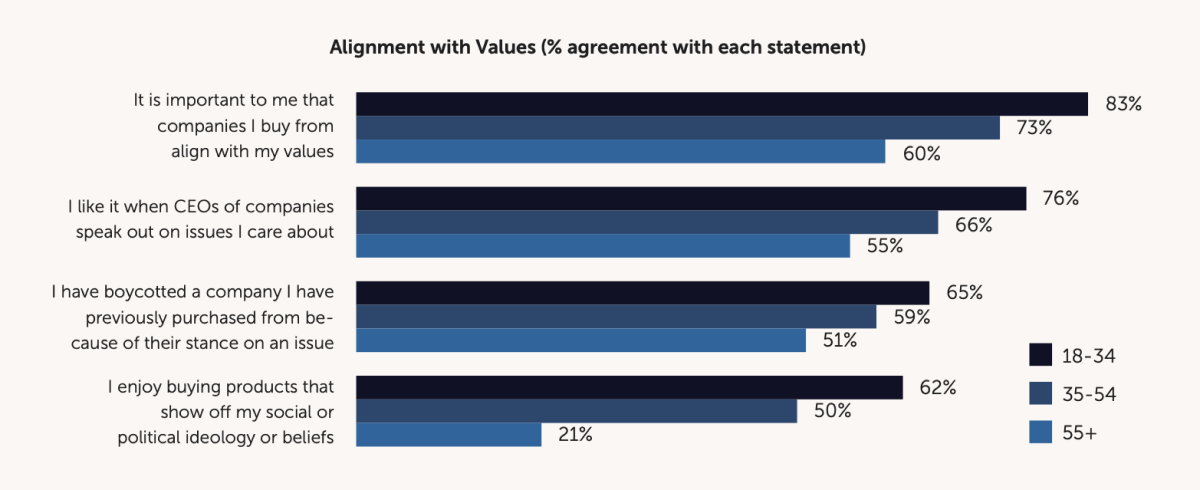
What is a code of conduct and why is it important? How do you enforce it? With examples from GM, L’Oréal, Sony, and Best Buy.

Demand Generation & Capture Strategist, Valamis
April 8, 2022 · updated July 10, 2024
A code of conduct is a vital asset for any company to have.
In this article you will learn:
A is a set of values, rules, standards, and principles outlining what employers expect from staff within an organization.
Often codes of conduct take big picture ideas tied to the business’s overall mission and core values and relate them to the behavior and practices they desire from employees on a day-to-day basis.
A code of conduct outlines leaders’ expectations and key ethical principles for success, reflecting the current or desired organizational culture.
A code of conduct is closely related to a code of ethics, to the extent where the phrases are often interchangeable.
However, while there is tremendous overlap, there is also a slight nuance between the two
Generally, both are combined into a single document, and an organization rarely has a different code for each.
A code of conduct in practice can range from big picture ideals to specific rules. For example, a code of conduct can outline how employees should behave to reflect the organization’s wider mission, but it can also define fixed regulations related to internal practices such as dress code or break policy.
A code of conduct could emphasize ethical attitudes and staff communication policies to prevent conflict or harassment while also outlining the consequences for poor behaving that violates the code.

Upgrade your organization’s learning culture with clear, actionable strategies to address the challenges.
You can think of adopting a code of conduct as the organization making a commitment to self-regulation. Leadership is putting into writing the conduct they expect from their employees and the ethical principles they want to guide them.
With a code of conduct in place, the organization has a framework to inform ethical decision-making for each and every stakeholder. While it isn’t a turn-key solution to every dilemma an employee faces, it shows employees the organization’s guiding principles and helps them make better choices in their daily activities.
A code of conduct is also a vital part of a company’s compliance and legal policies. For example, in the US, public organizations must have a code of conduct in place. Plus, from a compliance point of view, if an employee engages in illegal activity while at work, a code of conduct provides documentation showing they broke company policy.
By creating a code of conduct:
So far, we have focused on the internal effects of a code of conduct. But creating a code of conduct also has benefits in attracting new customers. Showing the values that the organization believes in, and backing it up with actions, can help engender a positive and receptive attitude from potential customers.
A Harvard Business Review survey shows the most significant driver of brand relationships is shared values (64%) . In addition, 5WPR’s 2020 Consumer Culture Report found company values are more important for younger generations. For example, 83% aged 18-34 (the age group often described as millennials) agreed with the statement, “It is important to me that companies I buy from align with my values.”
 The graph illustrates how millennials align with the company" width="1200" height="490" />
The graph illustrates how millennials align with the company" width="1200" height="490" />
The report shows the generational difference across several key factors related to alignment with values.
Being able to showcase the ethics and principles an organization stands for will only become more critical in the modern marketplace. Creating an accurate and honest code of conduct that reflects the organization’s beliefs is a great starting point to let customers know who they are supporting with their business.
While all businesses are different, and no two codes of conduct are the same, recurring factors and themes are found among successful ones.
Your organization’s specific purpose for adopting a code of conduct will define the scope to aim for. Some choose to focus on only the most essential values and guidelines to not overburden employees with information they may forget. Some seek to be more comprehensive and produce documentation covering as many aspects as possible.
Your code of conduct should include information in some form regarding:
It is also essential to define the procedures and consequences of code violations where applicable. It may be more challenging to identify a code of conduct violation when it comes to company values. However, employees should know the disciplinary processes for fixed rules (harassment, tardiness, etc.).
Finally, codes of conduct are typically prefaced with a letter from the CEO that provides a personal touch and emphasizes the leadership team’s commitment to the principles and rules it contains.
Listed below are important factors to consider for inclusion in your code of conduct. These are grouped into the four main areas described above. While covering every element detailed here may seem unrealistic, especially for new or small businesses, it is better to have something in place than react and define policies after an issue arises.
Details and topics related to the values the company holds itself to. This section allows the company to show the ethics and beliefs most dear to them and how they put this into action. This could include but is not limited to:
Within a code of conduct, leadership must explain to all employees what is expected of them in terms of behavior and performance. This could be related to how they treat the people around them and communicate or specifics related to how they perform their role. A company could cover numerous employee behavior topics within a code of conduct. Examples include:
In this instance, internal practices refer to defined rules related to day-to-day business practices that are easy to explain. While similar to employee behavior, it is hard to define a simple black and white definition for “Standards of professionalism.” That topic requires more explanation to convey the expectation to an employee. Whereas a company’s rules related to attendance and punctuality is a set thing that is simple to understand. Examples of the internal practices a code of conduct could contain include:
Finally, a code of conduct; should define the expectations for employees when dealing with external parties. For example, this could be in relation to confidential company material or a level of courtesy and respect when dealing with customers. There are many examples of external practices a code of conduct may define, such as:

Upgrade your organization’s learning culture with clear, actionable strategies to address the challenges.
Listed below are five real-world code of conduct examples from successful companies.
Multinational financial services corporation Visa has developed a detailed and wide-reaching code of business conduct and ethics with the slogan: “Integrity. Everyday. Everywhere.”

It opens with a letter from the CEO stating the company’s commitment to integrity and the need to continually earn the trust of their clients by acting with the highest ethical standards every day. The code of conduct is structured using Visa’s six leadership Principles:
Each section offers essential rules with explanations for implementation, valuable notes, examples, and links to relevant departments and other sources of additional information.
Visa’s code of business and ethics ends with a comprehensive list of resources to help when staff are unsure what to do in any situation. The list of issues or concerns along with the corresponding contact information is impressive and includes:
Japanese tech conglomerate Sony has an informative and extensive code of conduct covering many aspects of working at the company.
It starts with Sony’s purpose and core values, followed by messages from both CEO and Executive Vice President, the second of which poses the question:
“Does this contribute to a better future for Sony and a better future for our society?”
This question, along with Sony’s ethical values of Fairness, Honesty, Integrity, Respect, and Responsibility, form the basis of their code of conduct.
From there, the code of conduct is separated into eight areas:
 code of conduct contents page." width="1200" height="670" />
code of conduct contents page." width="1200" height="670" />
The code of conduct ends with an explanation of Sony’s ethics and compliance hotline. Maintained by a third party, it allows all employees to report concerns regarding breaks in the law or company policies, with the option to remain anonymous.
American automotive company General Motors (GM) have produced a comprehensive yet easy to navigate and understand code of conduct known as “Winning with Integrity.”

It begins with an opening message from the chairman and CEO, emphasizing their fundamental commitment to ethical and honest business conduct. Straight after this message is a page dedicated to safety; it places safety for both customers and employees at the heart of everything GM does, noting why this is so critical given the products they make and sell.
The code of conduct then introduces GM’s purpose:
And core values:
GM separate the code of conduct into four sections containing related topics:
Each section explains who it applies to, how the code will be enforced, and details the company’s expectations of its employees. It also has a recurring feature known as “Which Way?” that answers questions regarding potential situations where the code should guide the employees to the desired outcome. Finally, the code of conduct ends with some closing thoughts, policy links, and a list of additional resources.
French cosmetics company L’Oreal has developed an easy to follow code of ethics broken down into four sections:
“The L’Oreal Spirit” contains forewords by the CEO, Chief Ethics Officer, and the executive committee as a whole stating the commitment of the company to the code of ethics that follows. The remainder of the section contains information regarding who the code is for, how it should be used, how staff should work together, respect for human rights, and local laws and customs.

“Respecting our commitments as a business” details L’Oreals business practices concerning:
The final two sections, “Respecting our commitments as an employer” and “Respecting our commitments as a responsible corporate citizen,” explain company policy regarding how they treat employees and how they interact with the wider world.
Throughout the code, the company lays out its position through clear “We Must” and “We Must Not” lists and provides practical scenarios to demonstrate what they expect from staff. Each section also includes information and suggestions for who to report concerns to for the specific topic.
US electronics retailer Best Buy titled its code of ethics: “At our best. Every Decision. Every Day.”
It begins by describing Best Buy’s belief that “Magic” can happen when you connect each employee with the company’s purpose. Best Buy believes the purpose of a corporation should be to work towards a common good for its:
And these groups form the structure of the code of ethics with a section explaining Best Buy’s responsibilities and policies regarding each of the five.

The code continues with a message from the CEO and an introduction to Best Buys:
The code of ethics makes it clear who it applies to (every employee), what happens if it is violated, and the responsibilities every employee has. It emphasizes Best Buy’s expectations from its leaders and provides important details on how staff should raise concerns. In addition, Best Buy provides “What If?” examples throughout the code of ethics to show how it works in practice.
Designing and writing a code of conduct is great, but for it to have value it needs to be enforced successfully.
Enforcing a code of conduct starts by disseminating it widely throughout your organization. Need to be aware of the code of conduct to know the organization’s values and behave accordingly.
The most efficient way of spreading your code of conduct is through the employee handbook distributed during onboarding. In general, the process of orienting new employees is a vital time when the code of conduct needs to be made accessible and clearly explained.
In order to enforce the code of conduct, you must provide employees with effective communication channels for reporting violations. Managers should develop a safe and honest relationship with staff, so they feel confident discussing matters with them directly.
However, you should also provide anonymous channels that protect employees reporting problems. For example, if an employee has an issue with a superior or feels threatened and harassed, they may fear retribution and refrain from coming forward. The option of anonymity offers a level of protection for staff with knowledge of code violations and allows for greater enforcement.
Once a violation has occurred, you must gather as much information as possible from all parties involved to determine the facts, establish the severity of the issue, and respond accordingly. Consider if any laws have been broken and if other parties (police, attorneys, etc.) need to be involved.
When enforcing your code of conduct and dealing with violations, you must respond in a way that holds true to the values it contains. If leadership does not live up to the expectations defined for employees, it undermines the code of conduct and reduces morale. Always consider how the wider workforce will receive your response.
Did you like it? Help us spread the word!